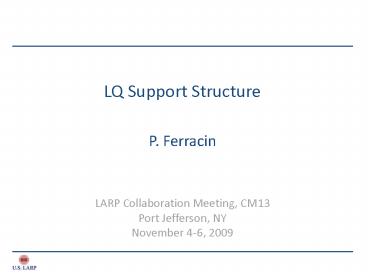LQ Support Structure - PowerPoint PPT Presentation
1 / 40
Title:
LQ Support Structure
Description:
LQ Support Structure – PowerPoint PPT presentation
Number of Views:18
Avg rating:3.0/5.0
Title: LQ Support Structure
1
LQ Support Structure
- P. Ferracin
- LARP Collaboration Meeting, CM13
- Port Jefferson, NY
- November 4-6, 2009
2
LQS01 magnet design
- Iron pads, masters and yokes
- 20 mm thick Al shell (500 mm OD)
- Pre-load with bladders and keys
- End support plate and rods
- Assembly of short segments
- Connection of segments
- Coil length 3.4 m
- Magnet length 3.7
3
CM12LQS assembly and cool-down with dummy coils
- LQSD modular assembly and loading with bladders
completed - First time with a 4 m long quad. structure
- Successful test of lifting / tilting operation
- LQSD cooled down to 77 K at FNAL
- Strain gauge results consistent with targets
- Magnet shipped back to LBNL
4
Outline
- LQSD disassembly
- Coil-pack practice assembly
- Coil instrumentation
- LQS01 assembly and loading
- Strain gauge measurements vs. targets
- Conclusions
5
LQSD coil-pack disassembly
6
Coil-pack assembly procedure
- Coils lifted with inner and outer strong backs
- Rotation performed with aluminum wheels
7
Load test of coil lifting beams
8
Bolting of inner lifting beam to practice coils
9
Rotation of practice coils
10
Bolting of outer lifting beam to practice coils
11
Placing practice coils on top of dummy coils
12
Coil-pack practice assembly
13
Tooling modifications (review 3)
- Scale, new rubber, bracket
- Wheels bolted and machined
14
LQ Instrumentation task (H. Felice)Coil
instrumentation
- 4 strain gauge stations
- ? and z with compensators
- Total of 32 gauges
- Strain relieves, spot heaters, wires for voltage
taps and protection heaters - High-pot and R meas.
- Individual coils, coil-pack, and magnet assembled
15
Outline
- LQSD disassembly
- Coil-pack practice assembly
- Coil instrumentation
- LQS01 assembly and loading
- Strain gauge measurements vs. targets
- Conclusions
16
Placing coil 6 and coil 7 on bottom pad
17
Placing coil 6 and coil 7 on bottom pad
18
Repeating lifting procedure with coil 8 and 9
and placing rotating wheels
19
Rotating coil 8 and coil 9
20
Placing outer lifting beam and lifting coil 8
and coil 9
21
Placing coil 8 and coil 9 on top of coil 6 and
coil 7
22
Lifting outer lifting beam and placing top pad
on top of coils
23
Coil pack assembly
24
Insertion of coil-pack
25
Coil-pack after insertionLead end return end
26
Bladder operation
27
G10 and stainless steel end pushers
28
Connecting coil instrumentation to shell
connectors and placing coil axial support
29
Preparation for lifting / shipping tooling
30
Support plates
31
LQS01 before shipment
32
Outline
- LQSD disassembly
- Coil-pack practice assembly
- Coil instrumentation
- LQS01 assembly and loading
- Strain gauge measurements vs. targets
- Conclusions
33
LQS01 target pre-stress Pre-load for 230/240 T/m
(13.2/13.8 kA)
- Shell
- Strain
- From 390/520 to 1710/1860 µe
- Stress
- From 30/40 to 150/170 MPa
- Coil pole
- Strain
- From -300/-400 to -700/-820 µe
- Stress
- From -40/-60 to -110/-130 MPa
- Coil peak stress 160/170 MPa
34
Shell and rod strain after loadingMeasurements
vs. computations
- Shell
- Computed 447 µe
- Measured 451 113 µe
- Rod
- Computed327 µe
- Measured 310 18 µe
- Measured
35
Shell and rod stress after loadingMeasurements
vs. computations
- Shell
- Computed 34 MPa
- Measured 33 8 MPa
- Rod
- Computed63 MPa
- Measured 60 3 MPa
36
Coil pole strain and stress after loading
Measurements vs. computations
- Coil ?? to -12 11 MPa
- Lower than comp. -49 MPa
- Not observed in LQSD
- Possibly related to coil dimensions
- Pre-loading strategy
- Shell tension chosen as reference
- Conservative approach for 1st test
- Corrections will be applied based on cool-down,
excitation
37
Outline
- LQSD disassembly
- Coil-pack practice assembly
- Coil instrumentation
- LQS01 assembly and loading
- Strain gauge measurements vs. targets
- Conclusions
38
Conclusions
- Successful scale-up of quadrupole shell-based
structure - 3.7 m long Nb3Sn magnet LQS01 assembled and
loaded - Structure characterized through cool-down tests
- Strain gauges data consistent with FEM
predictions - Shipping-lifting-tilting operations qualified
- LQS01 pre-load based on shell and rods gauges
- Room temperature targets for a 230-240 T/m
reached - Coil pre-load level to be verified during
cool-down and test - If required, it will be increased in next tests
- LQS01 now ready for its first test
39
LQSD strain gauges locationShell
- 2 4 2 2 stations at the center of each
shell segment - Each station with y and z gauges with temperature
compensators
40
LQSD strain gauge locationsStainless steel rods
- Each rod instrumented with 2 steel half bridge
biaxial gauges on opposite sides - Compensation for bending and temperature effect






























